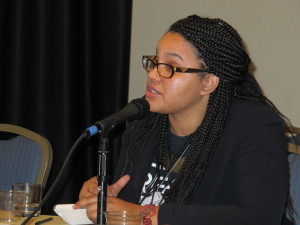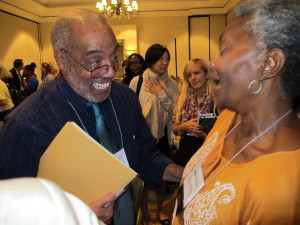You know you’re in Tampa, Florida, when the walkway from the conference hotel to the Tampa Bay History Center warns you to keep your eyes peeled for the iconic Florida creatures.
More than 420 oral historians from around the nation and from nine foreign countries examined stories of social change and social justice through an oral history lens at the Oral History Association’s 49th annual conference Oct. 14-18 in Tampa, Florida.
The conference featured keynote speakers, plenary sessions, panel presentations, roundtable discussions, interest group gatherings, a poster session, films, awards, performances, workshops, book signings and informal as well as inspiring opportunities to polish oral history skills and get new ideas for projects to pursue.
This first digital issue of the Oral History Association Newsletter highlights keynote speakers, plenary sessions and OHA news. The next issue will recap highlights from other conference sessions.
Plenary speaker Charles E. Cobb Jr. shares a story with OHA Council member Claytee White of the University of Nevada, Las Vegas, following Cobb’s luncheon talk about the Student Nonviolent Coordinating Committee Legacy Project.
Cobb’s passion: Preserve black freedom movement history
As a young man, Charles E. Cobb was a civil rights activist, working in Mississippi as a field secretary in the 1960s with the Student Nonviolent Coordinating Committee.
Now, at 72, after a prolific career as a bookstore owner, foreign correspondent for National Public Radio, National Geographic editorial staffer, author and college teacher, his passion is preserving the history of SNCC as a founder of the SNCC Legacy Project, which aims to document the history of the history-making movement.
“Understanding history involves more than collecting and archiving it or even writing books,” Cobb told an OHA luncheon audience. “The question is one of using history. How do you make it usable?”
It wasn’t until SNCC’s 50th anniversary in 2010 that movement members realized the importance of documenting the organization’s history, Cobb said.
“We never really grappled with our history,” he said. But at the 50th anniversary celebration, SNCC workers, now in their 60s and 70s or older, recognized the need to preserve their experience.
That realization led to the creation of the SNCC Legacy Project, which has three goals:
- Identify where SNCC-related materials are, whether in personal collections, attics, basements or garages;
- Raise money to support project needs and
- Generate new work pertaining to SNCC’s history.
Collecting old materials wasn’t sufficient, Cobb said. So a New Works Committee has initiated efforts to add new information, such as interviewing relatives of people who were killed for their support of SNCC.
The challenge, he said, is to present the history in usable ways. A key step in that direction came when Duke University approached the SNCC Legacy Project in a collaboration that resulted in www.onevotesncc.org, which incorporates essays, documents, maps, oral histories, timelines, short documentaries and other audiovisual materials to shed light on SNCC’s historic work.
Cobb noted that there often has been tension between participants in the movement and scholars who have studied it.
To historians, the focus has been mostly on charismatic leaders and national legislation, a civil rights history boiled down to “Rosa sat down, Martin stood up and the white folks saved the day,” Cobb said.
What too often has been missing is the bottom-up ideas that drove SNCC’s success. “These things didn’t happen for no reason,” he said.
The movement was full of people no one ever knew about but who were critically important as the young people learned how to be community organizers.
“The movement was really pretty practical,” Cobb said, figuring things out on the ground. “Sometimes what we tried to do worked; sometimes it didn’t.”
He said young people today who are involved in Dream Defenders and Black Lives Matter have sought out SNCC veterans to learn about their organizing experiences.
“Young people protesting today are beginning to realize that something more than protest is needed,” he said. “They’ll find their way, just like we did.”
“I tell young people today, ‘you all sound a lot like us,’” he said, drawing smiles from the audience.
And like the SNCC veterans learned, he said, today’s activists need to remember that “nothing gets done in a hurry.”
Oral history links disparate community activist themes
AIDS activists, Mexican barrios in El Paso and health care workers in Florida may seem to be disparate groups to connect in an OHA plenary session.
But oral history work in all those communities illustrates how community activists have used oral history in quests for social change.
Filmmaker and activist Jim Hubbard of the ACT UP (AIDS Coalition To Unleash Power) Oral History Project said the work of ACT UP, which forced attention to the high price of life-saving AIDs drugs, shows that “activism works.”
The oral history project includes 186 interviews, with transcripts and short video clips available online at www.actuporalhistory.org. The project is archived at Harvard University.
Hubbard said oral history was the best way to create a critical mass of information about AIDS. People in the trenches were the AIDS experts, he said, adding that he has “a great belief in citizen knowledge.”
Hubbard said the collection includes more than 350 hours of interviews, which form the basis for discussion of many issues central to the struggle for grassroots social change.
Grassroots activism also is at the core of a neighborhood oral history project described by Yolanda Chavez Leyva, history department chair at the University of Texas at El Paso and director of Museo Urbano, a museum without walls in El Segundo Barrio, an El Paso neighborhood on the border with Juarez, Mexico, which has the nation’s lowest income zipcode.
Chavez Leyva said the “museum of the streets” grew out of a city campaign to diminish the role of El Paso’s second ward by demolishing historic buildings in the name of redevelopment.
Community activists’ work to block the redevelopment led to an effort to document El Segundo’s history, which resulted in murals being painted on buildings slated for demolition and historical photos displayed on buildings, she said.
An effort to launch an oral history project of the neighborhood was dropped because of developers’ ties to the university, she said. “The project didn’t move forward, but the people did,” Chavez Leyva added, because a community group took up the oral histories instead.
Oral history projects have led to exhibits related to traditional healers in the community and garment workers who used to dominate the district. Chavez Leyva said El Paso may once again see a revived garment industry as Los Angeles companies eye a return to the Texas border city as a way to escape a new, higher minimum wage in L.A.
In a third example of using oral history to effect social change, Kim Diehl, writer and labor union communications coordinator, called her presentation “Oral History as a Tool for Worker Organizing in the Wild, Wacky, Hostile, Anti-Worker State of Florida.”
Diehl, a native Floridian transplanted to Brooklyn, said that as the daughter of a teacher and a union activist, she came early to her role as a labor organizer, and she described for the OHA plenary session attendees the four key steps of labor organizing:
- Develop leaders. Those are people who have followers.
- Create a supportive base of workers.
- Move the undecided or apathetic to become supporters.
- Isolate or neutralize the people who oppose you.
And that, she said, is just what they did in organizing health care workers in the Sunshine State, despite strong anti-worker sentiment in much of the South.
‘Guantanamo’ more than prison
Say the word “Guantanamo” to many Americans today, and mostly you’ll evoke images of a prison in Cuba where men believed to be connected to the 9/11 attacks have been incarcerated.
It also was a place, in the 1990s, where HIV-positive Haitian refugees were housed, and then a stepping stone to freedom for Cuban refugees rescued at sea who had sought to escape Cuban dictator Fidel Castro.
But long before that, it was a U.S. naval station built as a small town where people lived their lives and shaped community memories, Liz Sevcenko, founding director of the Guantanamo Public Memory Project, told an OHA plenary session audience.
Sevcenko and Patrick Moore, president of the National Council on Public History, described the project, started in 2011, in which student and faculty teams from more than a dozen universities studied the history of GTMO, conducted interviews with people who lived, worked, served or were held there as well as others associated with the base.
Groups also held community outreach activities to spark conversation about issues related to Guantanamo, including national security, immigration, public health, militarization and the future of the base, which President Obama wants to close.
Students found it shocking that Guantanamo was a place people called home, Sevcenko said.
In excerpts played for the audience, one woman interviewee recalled: “There was no crime…It was summer all year round. It was wonderful growing up there in the ‘60s.” She said she wanted to go back.
A Cuban refugee, speaking in Spanish, said: “It felt like a prison.”
And a contemporary detainee there called it “a place where people lose their minds.”
Moore, who is founder and director of the Public History Program at the University of West Florida, began GTMO interviews in 2001 when, at the invitation of the base commander, he took a team of graduate students to conduct oral histories of Cuban exiles there and citizens who commute to work on the base, a labor force relied upon for decades. The interviews were sealed for 20 years.
That planted the seeds for the larger, national project, which culminated in December 2012 with an exhibit in New York City based on display-window-sized posters with text and images featuring people with radically different experiences of Guantanamo.
QR codes on the posters enable visitors to listen to interview excerpts, which also can be found at www.gitmomemory.org.
The posters created a cheap, lightweight, easy-to-hang exhibit that has toured to more than 20 cities and has been seen by more than 550,000 people, Sevcenko said.
Interviewers for the public memory project found prospective interviewees in various ways.
In Pensacola, Florida, for example, Moore said, Guantanamo doesn’t evoke negative images, so the project simply advertised for people who had stories they wanted to tell. They also found oral history opportunities in reunion groups associated with the 50th anniversary of the Cuban missile crisis.
Moore said the community discussions that have emerged in connection with the exhibit tour have focused on aspects of the Guantanamo experience that might relate to specific local issues. In Indianapolis, for example, the community was grappling with the implication of super max prisons.
Through the exhibit-sparked discussions, people have been able to come to an understanding that there are other sides to an issue, he said.
“Through oral history, you really can get liberals and conservatives to talk to each other,” he said.
 Nailah Summers of Gainesville, Florida, tells a plenary session audience that social media helped fuel community protest after neighborhood watch coordinator George Zimmerman was acquitted in the shooting death of unarmed black teenager Trayvon Martin. Summers is a founding member of Dream Defenders.
Nailah Summers of Gainesville, Florida, tells a plenary session audience that social media helped fuel community protest after neighborhood watch coordinator George Zimmerman was acquitted in the shooting death of unarmed black teenager Trayvon Martin. Summers is a founding member of Dream Defenders.
Documenting Ferguson poses challenges for oral historians
The St. Louis suburb of Ferguson, Missouri, erupted in violent protests following the death of an unarmed black teenager shot by a white police officer on Aug. 9, 2014. The protests and the longer-term youth activism that emerged, fueled significantly by social media, raise important issues for oral historians interested in documenting events in real time, members of a plenary session panel told an OHA audience.
What does it mean to apply historical methods to contemporary issues, asked panel moderator Donna Murch, associate professor of history at Rutgers University.
The preponderance of digital media involved throughout the protests create important sources, she noted, but while social media communications represent “a form of utterance,” it remains to be seen whether they should be considered “oral” sources.
Murch described conditions in Ferguson, where the population is two-thirds African American and the city is a place of “profound divestment.” In many ways, she suggested, it is an example of a place that has been abandoned by the larger community.
People who took to the streets following Michael Brown’s death “showed us how to protest,” Murch said, noting that unemployed people have time to protest.
“This is not a population of elite college students,” Murch said.
Among other outcomes of the dramatic events, librarians at Washington University in St. Louis created Documenting Ferguson, https://digital.wustl.edu/ferguson/, a digital archive to collect and preserve digital materials related to the Michael Brown protests.
Librarian Makiba Foster said the library realized that it needed to be a content creator because otherwise, materials like smartphone photos will be lost.
She said the university is collaborating with other institutions to come up with ways to collect Twitter and Instagram messages related to the Ferguson protests.
Social media also were critical in the youth-led protests following the death of Trayvon Martin, an unarmed black teenager shot by a neighborhood watch coordinator in Sanford, Florida, on Feb. 26, 2012.
Martin’s death sparked the creation of Dream Defenders, which panelist Nailah Summers, a founding member, described as “angry Florida students.”
“This history is being written…by people with smartphones,” she said, adding that they used social media to create community.
But Dream Defenders activists also discovered that constantly using social media also takes away time from learning how to be community organizers and to recognize that one of the downfalls of social media is the digital divide between young people who have grown up with it and older people who haven’t. Church ladies, for example, aren’t on Twitter.
But people who don’t rely on social media can’t be ignored if social activism is to succeed, Summers suggested. “It’s our job not to leave anyone behind.”
OHA business meeting addresses concerns
OHA President Paul Ortiz told members attending the organization’s annual business meeting that Council members recognized concerns raised about labor disputes at California hotels, including the Long Beach Renaissance, site of the 2016 OHA meeting.
OHA would forfeit more than $100,000 if it pulled out of its contract with the hotel, Ortiz said, but the OHA Council has established a committee to develop guidelines for future conference site selection. Members interested in serving on that committee should contact incoming president Annie Valk.
Karen Harper, local arrangements chair for the Long Beach conference, said she would research the labor dispute at the Renaissance to determine whether it would be appropriate for the OHA to write a letter supporting hotel workers there.
Rosalie Riegle of Michigan suggested next year’s conference organizers might include a panel of oral historians working on projects with maintenance and service workers.
In other business meeting notes:
Ortiz announced the OHA’s 50th anniversary endowment campaign, with a goal of 100 percent participation by OHA members.
OHA Executive Director Cliff Kuhn invited members to comment on a new Council policy on public resolutions. Under the policy guidelines, public statements would be expected to address matters specifically of professional concern to oral historians and would be submitted to Council 45 days before an annual meeting. Proposed statements would be reviewed by an ad hoc committee, which would make recommendations to Council regarding submission of the proposed statement to members attending the annual business meeting. Details can be found at www.oralhistory.org.
Kuhn also announced that OHA membership has increased more than 15 percent over 2014, when the OHA executive office took over membership management that previously was handled by Oxford University Press, which publishes the Oral History Review.


